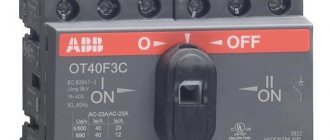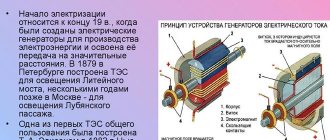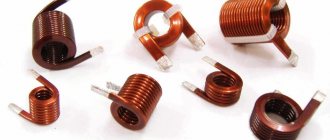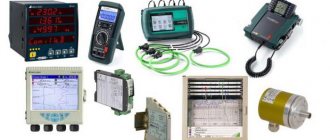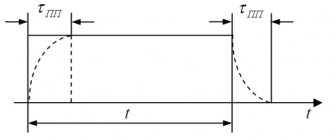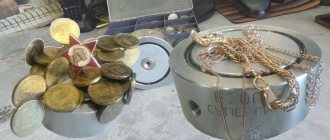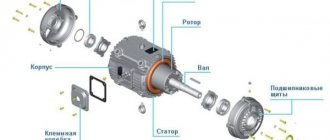Along with pieces of amber electrified by friction, permanent magnets were for ancient people the first material evidence of electromagnetic phenomena (lightning at the dawn of history was definitely attributed to the sphere of manifestation of immaterial forces). Explaining the nature of ferromagnetism has always occupied the inquisitive minds of scientists, however, even now the physical nature of the permanent magnetization of some substances, both natural and artificially created, has not yet been fully revealed, leaving a considerable field of activity for modern and future researchers.
Traditional materials for permanent magnets
They have been actively used in industry since 1940 with the advent of alnico alloy (AlNiCo). Previously, permanent magnets made of various types of steel were used only in compasses and magnetos. Alnico made it possible to replace electromagnets with them and use them in devices such as motors, generators and loudspeakers.
This penetration into our daily lives received a new impetus with the creation of ferrite magnets, and since then permanent magnets have become commonplace.
The revolution in magnetic materials began around 1970, with the creation of the samarium-cobalt family of hard magnetic materials with previously unheard-of magnetic energy densities. Then a new generation of rare earth magnets was discovered, based on neodymium, iron and boron, with a much higher magnetic energy density than samarium cobalt (SmCo) and at an expectedly low cost. These two families of rare earth magnets have such high energy densities that they can not only replace electromagnets, but be used in areas that are inaccessible to them. Examples include the tiny permanent magnet stepper motor in wristwatches and the sound transducers in Walkman-type headphones.
The gradual improvement in the magnetic properties of materials is shown in the diagram below.
What is a magnet? Properties and characteristics of magnets
To understand the essence of magnetism and substances called magnets, it is necessary to delve a little deeper into the theory of electromagnetic interaction and the internal structure of solids. Physicists have established a fundamental law: “A magnetic field arises around any moving electric charge, and a magnetic field acts on any moving charge.” The law was confirmed experimentally by the experiments of Oersted and Ampere and all electric charges obey it - electrons, protons, ionized atoms and molecules.
From the school physics course we know that all matter consists of atoms and molecules, representing a complex structure of nucleons and electrons rotating around them. That is, in every physical body, regardless of its phase state, there is a huge number of moving charges. This means that a magnetic field must also arise. Why do some substances have it, while others do not?
Why do substances become magnetized?
The fact is that the movement of electrons in orbits is chaotic, and the magnetic field has a directional effect. If you take any magnet, you can easily notice two poles - north and south. Magnets interact like electric charges “plus” and “minus”. Things of the same name attract, things of the same name repel. The magnetic poles are the same - the north one is attracted to the south, but repelled from the north, and vice versa.
Inside ordinary matter, magnetic fields with a certain orientation of field lines arise around each atom. Their direction is as chaotic as the rotation of electrons. The fields cancel each other out and there are none around the massive body.
But there are a number of substances in which a significant part of the atoms are arranged in a certain order. Atoms form spatial structures, domains, with an oriented magnetic field. The poles of the domains are directed in one direction, and the substance turns into a magnet at the macroscopic level. What do we call a magnet? An object that can attract certain metals, act on a current-carrying conductor, or another magnet at a distance. A magnetic field, like an electric one, is remote. To begin interaction, the bodies should not touch each other, but only be close. The distance varies from a few millimeters to hundreds and thousands of kilometers.
Types of magnets
But most of these fields are so low in intensity that we cannot detect them even with the help of special instruments. At the same time, there are substances in nature in which the arrangement of atoms in the crystal lattice differs in a certain direction and a magnetic field constantly surrounds them. One of these substances is magnetic iron ore, or magnetite. As technology developed, the need for magnets increased. Scientists have developed formulations of iron-based alloys that had higher magnetic properties - these are steels containing tungsten, cobalt, chromium, nickel, aluminum, and copper. Such substances, placed in an electromagnetic field, are easily magnetized, and after the field is turned off, they retain magnetization. Products made from such material are called permanent magnets. Ferrite magnets based on iron oxide and barium and strontium oxides are widely used.
Neodymium magnets have a stronger field. They are made from an alloy of iron, neodymium and boron. They are distinguished by their small size, but very high adhesion force at close range.
Electromagnets are a class of substances in which magnetism appears only when current passes through a coil wound around a core of this material. These are so-called ferromagnets. They are perfectly magnetized, but do not retain a residual field after turning off the current. Example - steel E1, E2, E3, E4.
go to sections
Related Products
Neodymium magnet - rod 5x25 mm
Diameter, mm - 5 Height, mm - 25 Dimensional tolerance, mm - +/-0.1 Magnetic properties: Br >...
36.00 rub.
Neodymium magnet disk 12x10 mm
Diameter, mm - 12 Height, mm - 10 Dimensional tolerance, mm - +/-0.1 Magnetic properties: Br &g...
91.00 rub.
Neodymium magnet disk 50x30 mm, N38
Diameter, mm - 50 Height, mm - 30 Dimensional tolerance, mm - +/-0.1 Magnetic properties: Br &g...
RUB 3,650.00
Neodymium magnet disk 50x30 mm, N42
Diameter, mm - 50 Height, mm - 30 Dimensional tolerance, mm - +/-0.1 Magnetic properties: Br &g...
RUB 3,700.00
Neodymium permanent magnets
They represent the latest and most significant development in this field over the past decades. Their discovery was first announced almost simultaneously at the end of 1983 by metal specialists from Sumitomo and General Motors. They are based on the intermetallic compound NdFeB: an alloy of neodymium, iron and boron. Of these, neodymium is a rare earth element extracted from the mineral monazite.
The enormous interest that these permanent magnets have generated arises because for the first time a new magnetic material has been produced that is not only stronger than the previous generation, but is more economical. It consists mainly of iron, which is much cheaper than cobalt, and neodymium, which is one of the most common rare earth materials and has more reserves on Earth than lead. The major rare earth minerals monazite and bastanesite contain five to ten times more neodymium than samarium.
Physical mechanism of permanent magnetization
To explain the functioning of a permanent magnet, we must look inside it down to the atomic scale. Each atom has a set of spins of its electrons, which together form its magnetic moment. For our purposes, we can consider each atom as a small bar magnet. When a permanent magnet is demagnetized (either by heating it to a high temperature or by an external magnetic field), each atomic moment is oriented randomly (see figure below) and no regularity is observed.
When it is magnetized in a strong magnetic field, all atomic moments are oriented in the direction of the field and, as it were, interlocked with each other (see figure below). This coupling allows the permanent magnet field to be maintained when the external field is removed, and also resists demagnetization when its direction is changed. A measure of the cohesive force of atomic moments is the magnitude of the coercive force of the magnet. More on this later.
In a more in-depth presentation of the magnetization mechanism, one does not operate with the concepts of atomic moments, but uses ideas about miniature (of the order of 0.001 cm) regions inside the magnet, which initially have permanent magnetization, but are randomly oriented in the absence of an external field, so that a strict reader, if desired, can attribute the above physical The mechanism is not related to the magnet as a whole. but to its separate domain.
Report No. 2
A magnet is, as a rule, a solid body with its own magnetic field that attracts or repels other bodies. The simplest magnet is considered to be an electron, although other elementary particles (proton, neutron, etc.) also have magnetic properties.
Magnets are usually divided into two types:
- Permanent magnets are natural iron-containing ferromagnets that can be found in nature, or products made of iron, cobalt, nickel and various alloys, which have their own magnetic field regardless of the influence of external forces.
- Electromagnets are devices whose magnetic properties arise due to electric current flowing through them.
There are also paramagnetic substances, for example, aluminum, oxygen, platinum, which are weakly attracted to a magnet. Diamagnets (such as bismuth, silver, copper, water), on the contrary, are repelled from a magnet.
Judging by various sources, people have been familiar with the phenomenon of magnetism for at least 4000 years. One of the first materials discovered by man that attracts iron was magnetite, an ore of magnetic iron ore known to the ancient Greeks. Ancient Indians and Mediterranean peoples were able to use magnets for orientation, thereby exploiting their interaction with the Earth's magnetic field. About 2.5 thousand years ago, the Chinese invented the first compass known to us.
Scientists began to study the properties of magnets only in the Middle Ages. Thus, the Frenchman Peter Peregrin in the 13th century discovered the poles of a magnet, conventionally designated as the north, from which the magnetic field lines emerge, and the south, into which these lines enter. The poles of a magnet cannot be separated, but thanks to them there are two types of magnetic interaction - attraction and repulsion. In the 16th century, William Gilbert stated that the Earth itself was a magnet. Finally, in the 19th century G.H. Oersted proved the existence of interaction between electric current and a magnet, which opened a new milestone in the development of the doctrine of magnetism and electricity. Later, his works were continued by Ampere, Faraday, Kelvin, Maxwell, thanks to whom we received a modern understanding of electromagnetic interaction - one of the five fundamental forces of nature.
Life is impossible without magnets, since it is the Earth's magnetic field that protects us from solar radiation. A person would not be able to travel and they are used everywhere - in wearable gadgets, all kinds of sensors, household appliances, vehicle components, and even in banknotes and bank cards.
8th grade physics
Induction and magnetization
The atomic moments are summed up and form the magnetic moment of the entire permanent magnet, and its magnetization M shows the magnitude of this moment per unit volume. Magnetic induction B shows that a permanent magnet is the result of an external magnetic force (field strength) H applied during primary magnetization, as well as an internal magnetization M due to the orientation of atomic (or domain) moments. Its value in the general case is given by the formula:
B = µ0 (H + M),
where µ0 is a constant.
In a permanent ring and homogeneous magnet, the field strength H inside it (in the absence of an external field) is equal to zero, since, according to the law of total current, the integral of it along any circle inside such a ring core is equal to:
H∙2πR = iw=0, whence H=0.
Therefore, the magnetization in a ring magnet is:
M= B/µ0.
In an open magnet, for example, in the same ring magnet, but with an air gap of width lzaz in a core of length lser, in the absence of an external field and the same induction B inside the core and in the gap, according to the law of total current, we obtain:
Hser l ser + (1/ µ0)Blzaz = iw=0.
Since B = µ0(Hser + Mser), then, substituting its expression into the previous one, we get:
Hser(l ser + lzaz) + Mser lzaz=0,
or
Hser = ─ Mser lzaz(l ser + lzaz).
In the air gap:
Hzaz = B/µ0,
wherein B is determined by the given Mser and the found Hser.
Study of the dependence of the interaction force between magnets
Study of the dependence of the interaction force between magnets
Introduction
A magnet is a body that has its own magnetic field. Perhaps the word comes from ancient Greek. Μαγνῆτις λίθος (Magnētis líthos), “stone from Magnesia” - from the name of the region of Magnesia and the ancient city of Magnesia in Asia Minor, where deposits of magnetite were discovered in ancient times. A permanent magnet, a product of a certain shape (for example, in the form of a horseshoe, strip, rod) from pre-magnetized material capable of retaining magnetization after removal of the magnetizing field.
Although magnets were known earlier than electric charges, the nature of the interaction of magnets was explained only in the 19th century, much later than the interaction of electric charges.
There is a magnetic field around magnets. It is convenient to show it graphically using lines of force. M. Faraday proposed using iron filings for these purposes.
And in our time, the magnetic field has not yet been fully studied. New hypotheses are being put forward, the authors of which are trying to explain its nature. The Earth is a giant permanent magnet
Of particular interest are the magnetic fields of several magnets. I tried to determine whether such a field would be similar to the field of a single magnet or whether it would have its own characteristics.
Therefore, in my work I decided to consider the magnetic fields of spherical magnets.
Goals and objectives of the study:
- Drawing an analogy between magnetic and electric fields.
- Study of magnetic fields of spherical magnets and their power characteristics.
- Determination of the interaction force of spherical magnets and its dependence on various factors.
The main research method in this work is physical experiment. In the first part of the work, I examined the magnetic fields of one and several magnets using iron filings. In the second part we studied the characteristics of the magnetic field. When determining the interaction force of the magnets, I applied my measurement method using lever scales. Based on the research, I drew my conclusions, which could differ from the theoretical ones.
Dependence of the interaction force of two spherical magnets on the distance between them
As the distance between the magnets increases, the strength of their interaction decreases.
The main difficulty is to measure the strength of this interaction. We suggested using lever scales for these purposes. The measurement scheme is shown in Figure 1.
Fig. 1 Scheme for measuring the interaction force between magnets
The scales are balanced and the same ball-shaped magnet is added to each cup. Another magnet is placed under the right cup and secured. Weights are added to the left pan of the scale and when the force of gravity becomes greater than the force of interaction between the magnets on the right, a gap will occur between the right magnets. Thus, the force of interaction between the magnets will be equal to the force of gravity that acted on the left cup before the last addition of weights. The minimum mass of the weights that we used was 1 g. Therefore, the error in measuring force will be approximately equal to 0.01 N. This is at least 10 times more accurate than a school dynamometer.
I increased the distances between the magnets by adding 1.85 mm thick glass plates between them (measurements were carried out using a micrometer).
While taking measurements, I noticed that the more magnets are in contact, the greater the force of their interaction. That is, it can be assumed that the magnets additionally magnetize each other, and this takes some time. We had to take repeated, more careful measurements.
The measurement results are presented in Table 1.
| Distance between magnet centers, mm | Interaction force, N | Average force, N | ||||
| 1 | 2 | 3 | 4 | 5 | ||
| 21,25 | 2.98 | 2.91 | 2.93 | 2.90 | 2.95 | 2.93 |
| 23.10 | 1.90 | 1.80 | 1.86 | 1.81 | 1.85 | 1.84 |
| 24.95 | 1.26 | 1.25 | 1.29 | 1.26 | 1.28 | 1.27 |
| 26.80 | 0.85 | 0.81 | 0.79 | 0.85 | 0.81 | 0.82 |
| 28.65 | 0.65 | 0.64 | 0.65 | 0.61 | 0.59 | 0.63 |
| 30.50 | 0.51 | 0.48 | 0.44 | 0.52 | 0.45 | 0.48 |
| 32.35 | 0.40 | 0.35 | 0.38 | 0.39 | 0.37 | 0.38 |
Table 1. Values of the interaction force between magnets depending on the distance between them
Dependence of the interaction force on the number of magnets
Let's study the dependence of the interaction force between magnets on their number. We will measure the interaction force in the same way as in previous experiments. The results are shown in Table 3.
| Number of magnets | Interaction force, N | Average force, N | ||||
| 1 | 2 | 3 | 4 | 5 | ||
| 1 | 2.20 | 2.15 | 2.16 | 2.20 | 2.15 | 2.17 |
| 2 | 2.43 | 2.44 | 2.47 | 2.47 | 2.40 | 2.44 |
| 3 | 2.60 | 2.50 | 2.60 | 2.63 | 2.57 | 2.58 |
| 4 | 2.62 | 2.61 | 2.61 | 2.65 | 2.58 | 2.61 |
| 5 | 2.64 | 2.61 | 2.61 | 2.65 | 2.60 | 2.62 |
Table 3. Values of the interaction force between magnets depending on the number of magnets
Based on the results of the experiments, we will construct a graph.
Graph 2. Dependence of the interaction force between magnets on the number of magnets
As the number of magnets increases, the strength of their interaction increases. But the dependence is not proportional. I explain this fact by the fact that the interaction involves, on the one hand, one magnet, and on the other, a system of several magnets. As the number of magnets increases, the distance from the center of the magnet system to the center of the magnet increases, which leads to a decrease in the interaction force. Thus, the total interaction force on the one hand increases (the number of magnets increases), on the other hand it decreases. When the number of magnets is more than five, the interaction force between the magnets remains virtually unchanged. By studying the interaction between magnets of different shapes, we determined that the smaller the distance between the poles, the stronger this dependence will be.
Conclusion
Summing up the results of the work, we can draw the following conclusions:
- The magnetic field lines are similar to the electric field lines created by two unlike charges.
- The Earth's magnetic field is similar to the magnetic field of a spherical magnet, which differs from the field of a flat magnet in the radius of curvature of the field lines.
- The magnetic field of several magnets located along one straight line differs from the magnetic field of a single magnet in the radius of curvature of the field lines and the presence of regions in which the total magnetic field is zero. These areas are located in the center of the magnets and where the magnets touch. The total number of such places is 2N – 1, where N is the number of magnets. In general, a system of several magnets behaves like one whole elongated magnet, with the exception of the central region, where the field has a complex structure.
- If the magnets are closed, we obtain a symmetrical magnetic field, the number of symmetry elements of which is equal to 2N.
- Ferromagnets in a magnetic field become magnets and make changes to the magnetic field. Moreover, if a ferromagnet touches one of the poles, it behaves like a magnet with one pole.
- It is convenient to measure the interaction force between magnets using lever scales.
- The more magnets are in contact, the greater the force of their interaction. The magnets additionally magnetize each other, and this takes some time. The phenomenon of magnetic hysteresis is observed.
- The force of interaction between magnets is not similar to electrical and gravitational interactions of the form (where r is the distance between the interacting elements). In our work, we obtained a dependence of the form (k = 1.27∙10-8 N∙m5). However, in our opinion, the dependence is even more complex.
- The force of interaction between magnets is not proportional to the number of magnets and practically does not change when the number of magnets is more than five, since with an increase in the number of magnets, the distance from the center of the magnet system increases, which leads to a decrease in the force of interaction. The total interaction force on the one hand increases (the number of magnets increases), on the other hand it decreases.
Magnetization curve
Starting from the unmagnetized state, when H increases from zero, due to the orientation of all atomic moments in the direction of the external field, M and B quickly increase, changing along section “a” of the main magnetization curve (see figure below).
When all atomic moments are equalized, M comes to its saturation value, and a further increase in B occurs solely due to the applied field (section b of the main curve in the figure below). When the external field decreases to zero, the induction B decreases not along the original path, but along section “c” due to the coupling of atomic moments, tending to maintain them in the same direction. The magnetization curve begins to describe the so-called hysteresis loop. When H (external field) approaches zero, the induction approaches a residual value determined only by atomic moments:
Br = μ0 (0 + Mg).
After the direction of H changes, H and M act in opposite directions and B decreases (part of the curve “d” in the figure). The value of the field at which B decreases to zero is called the coercive force of the BHC magnet. When the magnitude of the applied field is large enough to break the cohesion of the atomic moments, they are oriented in the new direction of the field, and the direction of M is reversed. The field value at which this occurs is called the internal coercive force of the permanent magnet MHC. So, there are two different but related coercive forces associated with a permanent magnet.
The figure below shows the basic demagnetization curves of various materials for permanent magnets.
It shows that NdFeB magnets have the highest residual induction Br and coercive force (both total and internal, i.e., determined without taking into account the strength H, only by the magnetization M).
Surface (ampere) currents
The magnetic fields of permanent magnets can be considered as the fields of some associated currents flowing along their surfaces. These currents are called Ampere currents. In the usual sense of the word, there are no currents inside permanent magnets. However, comparing the magnetic fields of permanent magnets and the fields of currents in coils, the French physicist Ampere suggested that the magnetization of a substance can be explained by the flow of microscopic currents, forming microscopic closed circuits. And indeed, the analogy between the field of a solenoid and a long cylindrical magnet is almost complete: there is a north and south pole of a permanent magnet and the same poles of the solenoid, and the patterns of force lines of their fields are also very similar (see figure below).
Are there currents inside a magnet?
Let's imagine that the entire volume of a bar permanent magnet (with an arbitrary cross-sectional shape) is filled with microscopic Ampere currents. A cross section of a magnet with such currents is shown in the figure below.
Each of them has a magnetic moment. With the same orientation in the direction of the external field, they form a resulting magnetic moment that is different from zero. It determines the existence of a magnetic field in the apparent absence of ordered movement of charges, in the absence of current through any cross section of the magnet. It is also easy to understand that inside it, the currents of adjacent (contacting) circuits are compensated. Only the currents on the surface of the body, which form the surface current of a permanent magnet, are uncompensated. Its density turns out to be equal to the magnetization M.
A magnetic field
Electrons moving around an atom create a magnetic field while carrying a negative charge. When constantly moving, an electric current is produced. The magnetic field appears due to the movement of current, the strength of the current affects the strength of the magnetic field.
Given this information, we can conclude that there is a connection between magnetism and electricity. Collectively, this phenomenon is called electromagnetism.
The movement of electrons around the nucleus is not the only reason for the appearance of a magnetic field. It is no less influenced by the movement of atoms around their axis. Individual materials have a magnetic field in which atoms suppress each other, carrying out chaotic movement.
Metal objects have ordered groups of atoms oriented in a certain direction. Thanks to the ability to direct atoms in a given direction and add magnetic fields, metal objects are able to be magnetized.
How to get rid of moving contacts
The problem of creating a contactless synchronous machine is known. Its traditional design with electromagnetic excitation from the poles of a rotor with coils involves supplying current to them through movable contacts - slip rings with brushes. The disadvantages of such a technical solution are well known: they are difficulties in maintenance, low reliability, and large losses in moving contacts, especially when it comes to powerful turbo and hydrogen generators, the excitation circuits of which consume considerable electrical power.
If you make such a generator using permanent magnets, then the contact problem immediately goes away. However, there is a problem of reliable fastening of magnets on a rotating rotor. This is where the experience gained in tractor manufacturing can come in handy. They have long been using an inductor generator with permanent magnets located in rotor slots filled with a low-melting alloy.
Permanent magnet motor
In recent decades, DC motors have become widespread. Such a unit consists of the electric motor itself and an electronic commutator for its armature winding, which performs the functions of a collector. The electric motor is a synchronous motor with permanent magnets located on the rotor, as in Fig. above, with a stationary armature winding on the stator. Electronic switch circuitry is an inverter of direct voltage (or current) of the supply network.
The main advantage of such a motor is its non-contact nature. Its specific element is a photo-, induction or Hall rotor position sensor that controls the operation of the inverter.
Strength and weakness of permanent magnets
Since electric current (its properties) is a consequence of the movement of electric charges, and the latter move relative to other stationary charges, various electrical interactions arise.
What should be understood by “pure” electric current? A pure or neutral current can, apparently, be called a situation when there are charges conditionally distant from others, consisting of an equal number of negatively and positively charged particles, some of which move relative to the others in the predominant direction. It is the mutual movement of charges of opposite signs relative to each other that is the neutral current. Other options for the movement of charges, for example, with a predominance of charges of the same sign, will in some way be derivatives of the neutral current and, accordingly, will have some features of electrical interactions.
In many situations, we are not dealing with neutral currents, since there is both an uneven distribution of charges along the length of current-carrying conductors, and jumps in the electric field strength at some boundaries of the conductors (the presence of current-causing EMF, etc.). Therefore, to study the properties of neutral current, one should use either a ring superconductor with current, or permanent magnets, which in this case can be conditionally considered as a system with a ring neutral current.
Ring currents of magnets
Considering permanent magnets as ring neutral currents, some general remarks can be made. The electric ring current is maintained without external recharge for quite a long time. The process of neutral current flow is not accompanied by heat generation or electromagnetic radiation (it simply maintains a thermal balance with the environment and the body of the permanent magnet).
Despite the fact that “magnetic” neutral ring currents, we will assume, are constant in magnitude, when magnets interact with each other, situations arise when both some transient processes and mutual influence of currents on each other are possible. In other words, the phenomenon of electrical mutual induction occurs.
The mutual induction of two current-carrying circuits in the presence of magnetic coupling is described in sufficient detail in the literature. It is known that the energy of two current-carrying circuits that have a magnetic connection differs from the sum of the currents’ own energies by the value of the mutual energy of the two currents. Extending this rule to the interaction of permanent magnets, we can say that the energy of a system of magnets differs from the total energy of each magnet. This is understandable, since mechanical work occurs when magnets move closer or further away.
But are the equivalent circular currents of permanent magnets constant in magnitude? Indeed, they represent, in a simplified way, the sum of a huge number of elementary molecular currents. But unlike other material bodies, a permanent magnet has an external and internal magnetic field, which “binds” all elementary currents, and each circular current reacts to the vibrations of the others, just as they, in turn, react to its vibrations. In other words, in a permanent magnet, all elementary currents represent, as it were, a single “organism,” which makes it a permanent magnet itself. If this “organism” is destroyed and each elementary current begins an independent “existence,” the magnetic properties of this object disappear.
Rotation is the key to efficiency
In a group of three magnets, the middle magnet “modulates” the total magnetic field of all three magnets. Moreover, the maximum density shifts to one side, and on the opposite side the magnetic field is practically absent. When the magnetic force of the middle magnet changes, a smooth change in the total field occurs, and the magnetic flux density seems to move to the other side.
What does this ultimately give? Since the middle magnet can simply be rotated, the maximum density of the total magnetic flux will move in a circle, equal to the rotation frequency of the middle magnet. In other words, one middle magnet can control the total field, which is the sum of the force of three magnets. Moreover, when the middle magnet rotates, there is no change in the total energy of the magnetic field, i.e., the rotation of the middle magnet occurs without energy consumption.
A rotating or changing direction maximum magnetic flux can be used in various devices - from the simplest pumps to engines or generators. All devices will be highly efficient and low power consumption.
Of course, rotating the middle permanent magnet is not the only practical use for a group of three permanent magnets in generators or motors. This middle magnet can be replaced with an electromagnet, through the winding of which alternating current of various shapes is passed (depending on the purpose or design).
Of greatest interest is the use of this effect in two types of engines: with linear reciprocating motion and rotational ones. The rotational torque of such engines can reach significant values at relatively low operating speeds.
Where can permanent magnets be used?
One of the features of motors with active use of permanent magnets is the possibility of using electrical resonance. Since the control electromagnet periodically changes polarity, i.e., it is powered by alternating current, the frequency of which determines the speed (in the case of a rotary motor) in the ratio 1 / K, where K is the number of poles, the electromagnets can be included in an oscillatory circuit with a capacitance. The connection of electromagnets can be series, parallel or combined, and the capacitance is selected according to resonance at the operating frequency of the motor, while the average value of the current passing through the electromagnets will be large, and the external current supply will compensate mainly for active losses.
This operating mode will be the most attractive from an economical point of view, and the motor in which it is used will be called a magnetic resonance stepper. The engine speed in this case is practically independent of the load and is determined by the frequency of the electrical resonance divided by the number of poles, despite the increase in current consumption with increasing load. In order to increase operating speeds, it is possible to use multiphase power supply circuits for motor electromagnets. The average expected reduction in electrical energy consumption of these magnetic resonance stepper motors can be up to 60-75% compared to conventional electric motors. Such motors are distinguished by a large torque, a fairly rigid load characteristic, a stable rotation speed, high reliability (the armature has no current-carrying elements), the absence of moving contacts and sparking, etc., so their area of application will have its own characteristics.
Despite this, they can surpass in some parameters both three-phase asynchronous and synchronous machines, and commutator DC motors. One of the main advantages is low energy consumption.
Generator with increased efficiency
The use of permanent magnets is effective, for example, in the design of an electric generator with a fixed rotor. The advantage of such generators is the absence of moving parts, high reliability, efficiency, and simplicity of design. The use of magnetic materials with special properties will allow for even greater efficiency. The average reduction in energy costs when producing electricity using generators of this type can reach 50% or more.
Their design is based on the principle of modulation of the total magnetic field of three permanent magnets by the middle magnet, which is an electromagnet. The use of permanent magnets makes it possible to achieve a reduction in energy costs when generating electrical energy.
The magnetic system of this generator is in general form a “cross in a ring”, where one of the crossbars of the cross is permanent magnets, and the other is a control electromagnet, the coil of which can be divided into two parts or used as a single coil. The ring is a magnetic circuit with low eddy current losses, on which there are 4 working windings (output windings), which are connected in pairs. The output voltage has double the frequency relative to the frequency of the current supplying the control electromagnet.
If, during the operation of a conventional generator (with a rotating rotor), the constant magnetic flux of the rotor (permanent magnets or electromagnet), rotating from an external drive motor, periodically changes the magnetic flux in the stator windings, then the mechanical costs on the part of the drive motor increase.
In the case of a stationary rotor, there are no friction losses and counteracting torque of the drive motor. In essence, this is a special type of transformer converter with additional recharge from the magnetic field of permanent magnets. In the process of converting the input AC current, the frequency of the output current doubles. Since the magnetic field of permanent magnets does not change its direction - only its periodic redistribution occurs among the sectors of the ring - it actively works, making its “contribution” to the generation of EMF.
The magnetic flux of the control or primary winding of the electromagnet changes sign, i.e., a process similar to that of a simple transformer occurs. The efficiency of transformer conversion is quite high. In other words, we get a frequency doubler transformer with increased efficiency.
What does this ultimately give? It turns out that the input power is at least less than the output power. The excess of the output power over the input occurs due to the energy of permanent magnets, which, unlike the usual generation circuit, are stationary.
Additional capabilities of this generator can be obtained by using magnetic materials with special properties for the annular stator core. The disadvantages of the device include the following: doubling the frequency of the output voltage, some complexity in the manufacture of magnetic cores and windings, the need for compensation windings to set the required load characteristics. The maximum power is determined mainly by the energy of the permanent magnets used, on which all other parameters depend.
To create a three-phase current, you can use either 3 similar converters (the power supply to the control windings is synchronized), or a similar design made in a three-phase version.
